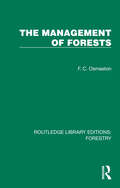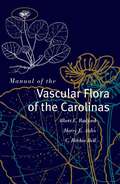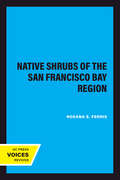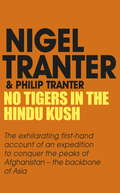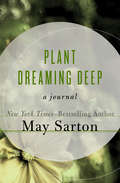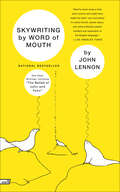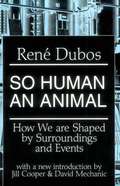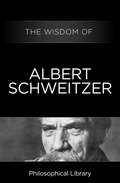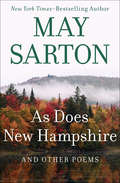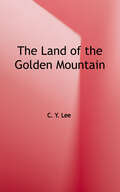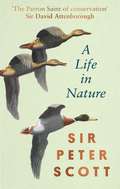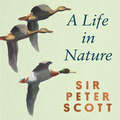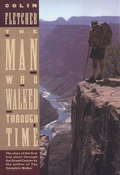- Table View
- List View
Come Spring
by Ben A. WilliamsAn historical novel, based on a real-life family who, with their large brood, helped found a frontier village in Maine during the Revolutionary war. The attempt in this book has been to tell the story of the founding of Union, a small Maine town, by ordinary people, in what was then an ordinary way. It was the way in which towns were founded from the Atlantic seaboard west to the great plains, by stripping off the forest and putting the land to work. People like these made this country, and towns like this one were and are the soil in which this country’s roots are grounded.
The Last Landscape
by William H. WhyteThis book is about the way our metropolitan areas look and the way they might look. Its thesis is that they are going to look much better, that they are going to be much better places to live in, and that one of the reasons they are is that a lot more people are going to be living in them. Many thoughtful observers believe the opposite is true. They hold that not only is the landscape of our cities and suburbs a hideous mess, as indeed much of it is, but that it is bound to become much worse. The saturation point has been reached, they say, and unless growth and population trends are redirected, our metropolitan areas will become fouler yet. Some think they are beyond redemption already and that the only real hope is to start afresh, somewhere else, with new towns and cities.
The Management of Forests (Routledge Library Editions: Forestry)
by F. C. OsmastonOriginally published in 1968, this book discusses the principles and methods on which forest management has been founded in the past and how these principles and methods still apply or are affected by modern management skills, changing demands, social habits and resources. The book is concerned mainly with the technical aspects of forestry and the classic foundations of management. To a lesser degree it deals with commercial efficiency, labour relations and the implications of these. The historical chapter shows the tends in the development of forestry, particularly in Europe.
Manual of the Vascular Flora of the Carolinas
by C. Ritchie Bell Harry E. Ahles Albert E. RadfordThis illustrated manual describes and discusses the unusually rich and varied flora of the Carolinas, from the semi-tropical coast of South Carolina to the northern forests of the high North Carolina mountains. The manual treats in detail and in a concise format more than 3, 200 species of trees, shrubs, vines, herbs and ferns that grow without cultivation in this two-state area. Special features include diagnostic illustrations, keys for identification, detailed descriptions, flowering and fruiting dates, habitat data, distribution data, and pertinent synonymy for each species. County dot maps show the distribution of each species if found in more than five counties throughout the two-state area, and general ranges beyond our borders are given in the text.First published in 1968, Manual of the Vascular Flora of the Carolinas is an established reference for professionals, students, and plant enthusiasts throughout the Southeastern United States. It is based on the collection and examination of more than 200,000 live specimens. Many of these specimens are now housed in the herbarium at the University of North Carolina at Chapel Hill
Native Shrubs of the San Francisco Bay Region (California Natural History Guides #24)
by Roxana S. FerrisThis title is part of UC Press's Voices Revived program, which commemorates University of California Press’s mission to seek out and cultivate the brightest minds and give them voice, reach, and impact. Drawing on a backlist dating to 1893, Voices Revived makes high-quality, peer-reviewed scholarship accessible once again using print-on-demand technology. This title was originally published in 1968.
No Tigers in the Hindu Kush
by Nigel Tranter Philip TranterPhilip Tranter and three friends drove a Land Rover 6,000 miles overland from Scotland to Nuristan to explore some of the unknown Central Hindu Kush area. They set out to attempt the second ascent of the monstrous Koh-i-Krebek; to ascend if possible at least one other major unclimbed mountain and to map that previously unmapped terrain. In fact, as well as Krebek they climbed nine other major peaks, named another dozen, and established the existence of a dramatic rock and ice range which they called the Rum Mountains, and christened individually after the Hebridean peaks they resembled in shape and beauty. The story of the expedition is told with an infectious enthusiasm for the glory and challenge of these mysterious peaks.
Occasional Prose
by Mary MccarthyA series of essays encompassing McCarthy's long literary career. The essays deal with varied subject matter, such as politics, language, history and nature.
Plant Dreaming Deep: A Journal
by May SartonThe author&’s tribute to the 18th-century New England farmhouse she called home: &“[A] tender and often poignant book by a woman of many insights&” (The New York Times Book Review). In Plant Dreaming Deep, Sarton shares an intensely personal account of transforming a house into a home. She begins with an introduction to the enchanting village of Nelson, where she first meets her house. Sarton finds she must &“dream the house alive&” inside herself before taking the major step of signing the deed. She paints the walls white in order to catch the light and searches for the precise shade of yellow for the kitchen floor. She discovers peace and beauty in solitude, whether she is toiling in the garden or writing at her desk. This is a loving, beautifully crafted memoir illuminated by themes of friendship, love, nature, and the struggles of the creative life. This ebook features an extended biography of May Sarton.
Plant Dreaming Deep: A Journal
by May SartonThe author&’s tribute to the 18th-century New England farmhouse she called home: &“[A] tender and often poignant book by a woman of many insights&” (The New York Times Book Review). In Plant Dreaming Deep, Sarton shares an intensely personal account of transforming a house into a home. She begins with an introduction to the enchanting village of Nelson, where she first meets her house. Sarton finds she must &“dream the house alive&” inside herself before taking the major step of signing the deed. She paints the walls white in order to catch the light and searches for the precise shade of yellow for the kitchen floor. She discovers peace and beauty in solitude, whether she is toiling in the garden or writing at her desk. This is a loving, beautifully crafted memoir illuminated by themes of friendship, love, nature, and the struggles of the creative life. This ebook features an extended biography of May Sarton.
Skywriting by Word of Mouth
by John LennonJohn Lennon wrote Skywriting by Word of Mouth, an impressive collection of writings and drawings, during Yoko Ono's pregnancy with Sean, and always planned to have it published. The book's publication was a wish that seemed to end with Lennon's assassination in 1980 and the theft of the manuscript from the Lennons' home in 1982. When it was recovered and first published in 1986, Skywriting received immediate critical and popular acclaim. Filled with Lennon's extraordinary creative powers and lavishly illustrated with his own drawings, the collection reveals his fertile creative spirit up close and in full force. Included in Skywriting are "Two Virgins," written when the public learned that John and Yoko were living together as husband and wife, and John's only autobiography, "The Ballad of John and Yoko." In addition there are notes on his falling in love with Yoko, the breakup of the Beatles, his persecution by U.S. authorities, and his withdrawal from public life. This is a book with John Lennon's spirit on every page—a spirit the world needs to remember.
So Human an Animal: How We Are Shaped by Surroundings and Events
by René DubosIn this collection of stories, the bizarre is rendered normal, the absurd hilarious and the incredible comprehensible. The re-imaginations of reality feature evocations of historical figures, over-televised game show hosts and late-night comedians.<P><P> Pulitzer Prize Winner
Why Frogs Are Wet (Let's-Read-and-Find-Out Science 2)
by Judy HawesRead and find out about frogs in this colorfully illustrated nonfiction picture book.Frogs can jump thirty times their own body length, catch insects on the wing, and breathe underwater or on land. But they must always keep their skins wet. Read and find out why! This is a clear and appealing science book for early elementary age kids, both at home and in the classroom. It's a Level 2 Let's-Read-and-Find-Out, which means the book explores more challenging concepts for children in the primary grades. The 100+ titles in this leading nonfiction series are:hands-on and visualacclaimed and trustedgreat for classroomsTop 10 reasons to love LRFOs:Entertain and educate at the same timeHave appealing, child-centered topicsDevelopmentally appropriate for emerging readersFocused; answering questions instead of using survey approachEmploy engaging picture book quality illustrationsUse simple charts and graphics to improve visual literacy skillsFeature hands-on activities to engage young scientistsMeet national science education standardsWritten/illustrated by award-winning authors/illustrators & vetted by an expert in the fieldOver 130 titles in print, meeting a wide range of kids' scientific interestsBooks in this series support the Common Core Learning Standards, Next Generation Science Standards, and the Science, Technology, Engineering, and Math (STEM) standards. Let's-Read-and-Find-Out is the winner of the American Association for the Advancement of Science/Subaru Science Books & Films Prize for Outstanding Science Series.
The Wisdom of Albert Schweitzer (Wisdom)
by The Wisdom SeriesReverence for Life—Albert Schweitzer&’s pivotal philosophyMusician, physician, humanitarian, and philosopher, Albert Schweitzer was a twentieth-century Renaissance man who won the Nobel Peace Prize for his &“Reverence for Life&” philosophy. The Wisdom of Albert Schweitzer explores this core philosophy, which inspired one of the world&’s great humanitarians. While traveling in Africa, Schweitzer recognized that all living creatures have a will to live and believed that through a &“reverence for life&” mankind had an ethical imperative to aid in the welfare of all living things, including the environment. His words have remained an inspiration for generations of humanitarians and environmentalists.
The Wisdom of Albert Schweitzer (Wisdom)
by The Wisdom SeriesReverence for Life—Albert Schweitzer&’s pivotal philosophyMusician, physician, humanitarian, and philosopher, Albert Schweitzer was a twentieth-century Renaissance man who won the Nobel Peace Prize for his &“Reverence for Life&” philosophy. The Wisdom of Albert Schweitzer explores this core philosophy, which inspired one of the world&’s great humanitarians. While traveling in Africa, Schweitzer recognized that all living creatures have a will to live and believed that through a &“reverence for life&” mankind had an ethical imperative to aid in the welfare of all living things, including the environment. His words have remained an inspiration for generations of humanitarians and environmentalists.
As Does New Hampshire: And Other Poems
by May SartonMay Sarton's exquisitely rendered tribute to her home state Over the course of her career, May Sarton wrote on a range of topics and places in both prose and poetry, and traveled across the world in search of new subjects. There is, however, one place that she always returned to in the end: Nelson, New Hampshire. Written in honor of the town's bicentennial, As Does New Hampshire follows the course of a year in this rural hamlet. Sarton gracefully describes the ever-present role of nature, which always reminds humans that their presence on earth is temporary. She conveys both the beauty and the difficulty of a New England winter, and the full bloom of spring and summer. Above all, though, As Does New Hampshire is a lasting tribute not only to Sarton's home, but to the greater concept of home found in the heart of every reader.
Cave Of Danger
by Bryce WaltonMat hopes to improve his family's financial troubles by discovering a new cave that no one else knows about. He thinks that charging the public for tours will bring his family the money they need. Getting lost in a cave gives Mat a different outlook on life, and teaches him things he never knew about himself.
The Land of The Golden Mountain
by C. Y. LeeSeeking a better life, losing everything, and yet finding a way to carry on. The trip across the Pacific to land was so strange and yet somewhat familiar. A story of family, loss, determination, friendship, travel, seafaring, and a gold rush. Learning to adjust and hold on to traditions. Disguising yourself to survive and yet yearning to show the world what beauty you possess.
A Life In Nature
by Peter Scott'The Patron Saint of Conservation' Sir David Attenborough'Peter Scott was a huge influence on my childhood...Later on in life I had the good fortune both to meet and to interview him, and he remains, for me, a hero. His knowledge, his kindness to me and his generosity of spirit have remained an influence in my own sphere of natural history....To meet one's heroes can sometimes be a let-down. That was most certainly not the case with Peter Scott.' Alan TitchmarshA Life In Nature is a portrait of Peter Scott collected from his own conversations, articles and broadcasts including thoughts on expeditions to Lapland, Conservation and Africa, his travels in Europe and much more. Illustrated by Peter's own beautiful illustrations. Sir Peter Scott had a truly incredible life. He was the only son of legendary explorer Captain Scott. His godfather was JM Barrie and he was married to Elizabeth Jane Howard. He also represented Great Britain and Northern Ireland at sailing in the 1936 Berlin Olympic Games, winning a bronze medal. He founded the Wildfowl and Wetlands Trust and also helped to found the Worldwide Fund for Nature.This is a beautiful and timely re-discovered book, perfect for those who are interested in preserving our planet.
A Life In Nature
by Sir Peter Scott'The Patron Saint of Conservation' Sir David Attenborough'Peter Scott was a huge influence on my childhood...Later on in life I had the good fortune both to meet and to interview him, and he remains, for me, a hero. His knowledge, his kindness to me and his generosity of spirit have remained an influence in my own sphere of natural history....To meet one's heroes can sometimes be a let-down. That was most certainly not the case with Peter Scott.' Alan TitchmarshA Life In Nature is a portrait of Peter Scott collected from his own conversations, articles and broadcasts including thoughts on expeditions to Lapland, Conservation and Africa, his travels in Europe and much more. Illustrated by Peter's own beautiful illustrations. Sir Peter Scott had a truly incredible life. He was the only son of legendary explorer Captain Scott. His godfather was JM Barrie and he was married to Elizabeth Jane Howard. He also represented Great Britain and Northern Ireland at sailing in the 1936 Berlin Olympic Games, winning a bronze medal. He founded the Wildfowl and Wetlands Trust and also helped to found the Worldwide Fund for Nature.This is a beautiful and timely re-discovered book, perfect for those who are interested in preserving our planet.
A Life In Nature
by Sir Peter Scott'The Patron Saint of Conservation' Sir David Attenborough'Peter Scott was a huge influence on my childhood...Later on in life I had the good fortune both to meet and to interview him, and he remains, for me, a hero. His knowledge, his kindness to me and his generosity of spirit have remained an influence in my own sphere of natural history....To meet one's heroes can sometimes be a let-down. That was most certainly not the case with Peter Scott.' Alan TitchmarshA Life In Nature is a portrait of Peter Scott collected from his own conversations, articles and broadcasts including thoughts on expeditions to Lapland, Conservation and Africa, his travels in Europe and much more. Illustrated by Peter's own beautiful illustrations. Sir Peter Scott had a truly incredible life. He was the only son of legendary explorer Captain Scott. His godfather was JM Barrie and he was married to Elizabeth Jane Howard. He also represented Great Britain and Northern Ireland at sailing in the 1936 Berlin Olympic Games, winning a bronze medal. He founded the Wildfowl and Wetlands Trust and also helped to found the Worldwide Fund for Nature.This is a beautiful and timely re-discovered book, perfect for those who are interested in preserving our planet.
Lucky Star (Bright Star #4)
by Patsey GrayOrdinarily, Debbie Bell never meddled in grownups’ concerns, especially her mother’s. This was an emergency, however, for Mr. Bayly, their ranch foreman and Debbie’s good friend and mentor, had announced he was leaving — and only because Debbie’s mother had stated, finally and definitely, that she would not marry him. Whatever would they do at the Bell Ranch without Mr. Bayly’s friendly presence and extensive knowledge of horses? Not a day went by that Deb didn’t ask him for advice about training her horse, Star Bright, or about the many other problems that came up. Most of all, Deb knew how her mother relied upon Mr. Bayly and how lonely she would be with him gone. There was only one thing to do, Deb decided: play Cupid. Somehow she’d have to get her mother to change her mind and agree to marry Mr. Bayly. Deb enlisted the rather reluctant help of her best friend, Maureen, in this scheme, but nothing, not even a moonlight picnic on the mesa, seemed to change the situation. Furthermore, Deb’s mother didn’t appreciate her meddling, and Deb couldn’t bring herself to broach the other question that was uppermost in her mind: showing Star Bright in his first horse show at the fair in nearby Laurel. Deb wasn’t at all sure her mother would allow it, and in any case, how could she show Star without Mr. Bayly’s guidance? Deb finally solved her problems about both Star and Mr. Bayly, but not before some amusing, and at times frightening incidents, with an important lesson learned in the end.
The Man Who Walked Through Time
by Colin FletcherFletcher is the first man ever to walk the entire length of the Grand Canyon. This is the story of his journey, 2 months of struggle against heat and cold, lack of water, dwindling supplies, and almost impassable terrain. But more than a mere adventure story, this is also a spiritual odyssey during which one man began to understand mankind's unique place in the vastness of nature.
The Man Who Walked Through Time
by Colin FletcherThe remarkable classic of nature writing by the first man ever to have walked the entire length of the Grand Canyon.
The Mystery of the Great Swamp
by Marjorie A. ZapfA young boy and his family living on the edge of the Okefenokee Swamp, Jeb discovers a strange and scary island he had never seen before. One day Jeb and his dog go out fishing and searching for the mysterious island with its beautiful Emerald Lake. A strong storm pushes Jeb to a place he had never been before. In his journey to find his way back home he unlocks the mystery to the Emerald Lake and the island.
Natural Resources and Public Property Under the Canadian Constitution (The Royal Society of Canada Special Publications)
by Gerard La ForestThe controversy aroused by the Supreme Court's decision on offshore mineral rights emphsizes the importance of the public domain in the workings of the Canadian constitution. Public property is important to the provinces not only for its revenues, but also because it provides them with a powerful instrument for control of their economic and political destinies and strengthens their position in relation to federal authorities. The provisions of the British North America Act and other constitutional instruments relating to natural resources and public property are examined thoroughly in this series of lectures given to doctoral systems at the Faulte de droit of the Universite de Montreal. Professor La Forest studies ownership of mines and minerals, navigable waters, public harbours, fisheries and Indian lands, as well as the currently controversial offshore mineral rights. He notes the political imlications of the partition of proprietary rights and explores the areas of conflict between the federal and provincial governments. Also included is a discussion of the power of expropriation, and, because public property involves public monies, lending and spending powers receive attention.In these lectures, Professor La Forest traces public domain in Britain from the time when the monarch controlled all the land, to his surrender of this control to parliament in return for a civil list, and to the similar surrender to the legislatures of the British North American colonies in connection with the struggle of responsible government.The collection of lectures is essential reading for any serious student of the constitution and will be very useful to all who are interested in the increasingly important law of natural resources in Canada.

